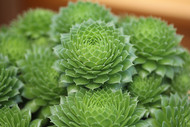Succulents: All the Juicy Details
Posted by John Friel on Sep 16th 2018
Need evidence that succulent plants are hot? Here’s some. In recent months, I was invited to speak on succulents at a fruit and vegetable convention, and to a local herb guild. Can you name two industry segments less likely to give a Rhipsalis about such stuff?
Succulents are everywhere: Garden centers, public and private gardens, even boutiques that stock no other plants. Their low-maintenance lifestyle makes them equally at home from windowsill to rock garden, from 8 cm (3-inch) pots to multi-acre green roofs.
This is no fad, not the Pet Rock of horticulture. But they have this in common with rocks: They’re hard to kill. Sedum is called “stonecrop.” Sempervivum means “Live forever.” Agave is called “century plant.”
People like plants they can ignore. If you leave for two weeks and nobody waters your houseplants, even your Swedish ivy will die. But your Kalanchoe and Crassula will barely notice. Outdoors, if drought hits and watering is banned, your Sedums and Sempervivums will be green islands in a brown sea.
What, exactly, is a succulent plant? Defining characteristics are a waxy epidermis, fewer and smaller pores than most plants, and mucilaginous sap. Succulents are built to suck up all the water they can hold, and hold it.
People use the term “succulent family,” but there’s no such thing. Succulence is a characteristic shared by many unrelated plants. But that one common trait makes them work, so they’re often thought of as interchangeable. At the MANTS show in Baltimore, I saw bulk URCs labeled simply “Succulents.” The vendor sells 40 varieties of Echeveria, plus numerous other genera, but the sign just said “Succulents.”
That bugged me. I write a perennial and grass catalog. I chaired the Perennial Plant Association’s nomenclature committee. I hate seeing plants sold without proper identification. Would you buy a tree labeled “fruit” without knowing if it produced mulberries or mangoes? Would you sprinkle “spice” into a stew?
IMPORTANT GENERA
There are three principal hardy succulent genera. Sedum, a.k.a. stonecrop, is the big one. Hundreds of varieties are on the market. The best breeding I’ve seen is by Terra Nova Nurseries. They’re known for their Heuchera, too, but their Sedum genetics are world-class. Intrinsic Perennial Gardens in Illinois has also produced some cool varieties. And Chris Hansen’s SunSparkler® series has exciting colours and forms. Low-growing Sedum varieties are the go-to living ingredient in green roofs, which cover everything from bird feeders to convention centers – a topic unto itself.
Next in importance comes Sempervivum, hen & chicks or house leeks. A new series, Chick Charms®, from Chris Hansen, breathes new life into the genus. As with his Sedum intros, the collection features hitherto-unseen colours and novel forms. Little Prince of Oregon Nursery has staked out a cool niche with Sempervivum in creative combos, marketed as “Water Misers®.”
Sedum and Sempervivum are the only genera that Emerald Coast Growers offers in mixed trays. Small- to medium-size growers need a good selection but balk at buying hundreds of plants.
Delosperma, a.k.a. ice plant, is a South African native that grows at high altitudes. Recent breeding has resulted in two nifty series, Jewel of Desert and Wheels of Wonder®, each with a wide range of colourful flowers. Check YouTube for some fun marketing featuring Peter Van Reisen of Concept Plants.
A personal fave of lesser importance: Lewisia, “bitterroot.” A mountain dwelling American native, it’s named for its discoverer, Meriwether Lewis. Lewisia sells better overseas than here; in Europe and the UK, it’s a very popular house plant.
In tender succulents, Echeveria is the workhorse genus. Some strongly resemble Sempervivum, and both are called “hen and chicks,” but there are significant differences. Echeveria, native to Mexico and South America, is hardy in Zones 9-11. Sempervivum is extremely hardy, down to Zone 3. Echeveria doesn’t die after flowering. In Sempervivum, the “hen” blooms and then dies out, leaving the offshoots, the “chicks,” to carry on.
Other key genera: Crassula, the jade plant; Aloe, with many decorative species besides the classic A. vera; Kalanchoe, in sizes ranging from teacup to 41 cm (16-inch) cut flower stems; Senecio; and even a tender Sedum, S. morganianum, a.k.a. “burro’s tail.”
Painted Succulents
Brilliant marketing, or crime against nature? The “value-added” trick of offering succulents in hues God never contemplated started overseas. I first saw them in Germany, at IPM Essen. But the practice has made landfall in the US, where color-enhanced Echeveria are even turning up in brides’ bouquets.
Trend Overlap
If there’s anything else as hot as succulents, it’s pollinator-friendly gardening. They intersect at Sedum. Bees LOVE Sedum, especially big-flowering spectabile types. At Terra Nova’s trial and display gardens, they seem to prefer darker colours.
You want natives with that? Native to eastern North America and hardy to Zone 3, Sedum ternatum is just 15 cm (6 inches) tall. Unlike most, it likes shade. Good luck sourcing it, though.
Hardy or tender, succulents are insanely popular. Their 15 minutes of fame has stretched into years – with no end in sight. Get juiced!
John Friel is marketing manager for Emerald Coast Growers, one of North America’s largest liner producers. For more information on perennials, specialty plants or ornamental grasses, call 1-877-804-7277, e-mail sales@ecgrowers.com or visit www.ecgrowers.com.
This article originally appeared in Greenhouse Canada Magazine.

